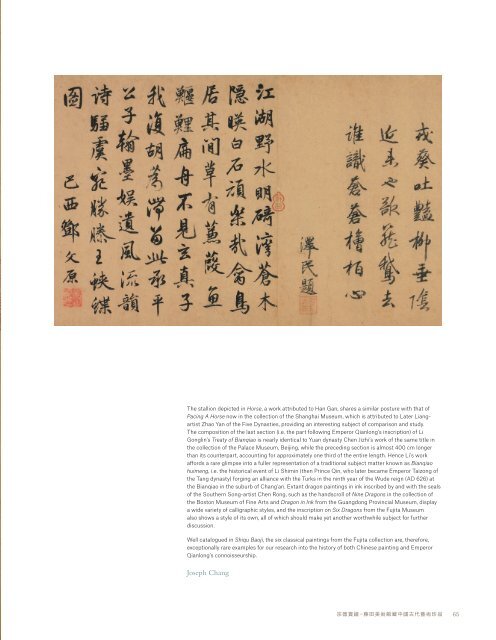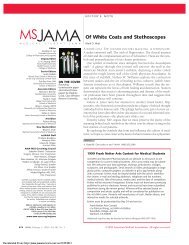- Page 4 and 5:
SPECIALISTS AND SERVICES FOR THIS A
- Page 6 and 7:
4
- Page 8 and 9:
6 IMPORTANT CHINESE ART FROM THE FU
- Page 10 and 11:
8 IMPORTANT CHINESE ART FROM THE FU
- Page 12 and 13:
10 IMPORTANT CHINESE ART FROM THE F
- Page 14 and 15:
For the elite new collector (the ne
- Page 16 and 17: Clockwise from upper left: Fujita T
- Page 18 and 19: Yohen tenmoku teabowl, Southern Son
- Page 20 and 21: 收 藏 家 藤 田 傳 三 郎 小
- Page 22 and 23: コレクター、 藤 田 傳 三
- Page 24 and 25: 22 IMPORTANT CHINESE ART FROM THE F
- Page 26 and 27: The cultural background of the inte
- Page 28 and 29: such as Duan Fang ( 端 方 ), and
- Page 30 and 31: 近 代 關 西 的 中 國 藝 術
- Page 32 and 33: 近 代 関 西 の 中 国 美 術
- Page 34 and 35: 32 IMPORTANT CHINESE ART FROM THE F
- Page 36 and 37: 34 IMPORTANT CHINESE ART FROM THE F
- Page 38: Fig. 1. Longquan vase, Yuan dynasty
- Page 41 and 42: Fig. 2. Longquan Vase, Ming dynasty
- Page 43 and 44: 北 :1998)。 四 川 巴 中 縣
- Page 45 and 46: (Longquan Celadon: The Sichuan Muse
- Page 47 and 48: 45
- Page 49 and 50: 47
- Page 51 and 52: 49
- Page 53 and 54: PAINTING 寶 繪 51
- Page 56: 505 WANG LIBEN (ATTRIBUTED TO, 13TH
- Page 60 and 61: 58 IMPORTANT CHINESE ART FROM THE F
- Page 62 and 63: It is interesting to note that four
- Page 64 and 65: 62 IMPORTANT CHINESE ART FROM THE F
- Page 68 and 69: 66 IMPORTANT CHINESE ART FROM THE F
- Page 70 and 71: 藤 田 美 術 館 舊 藏 《 石
- Page 72 and 73: LEGAL NOTICE 特 別 法 律 聲
- Page 74 and 75: 72 IMPORTANT CHINESE ART FROM THE F
- Page 76 and 77: 74 IMPORTANT CHINESE ART FROM THE F
- Page 78 and 79: 507 CHEN RONG (13TH CENTURY) AS CAT
- Page 81: 78 IMPORTANT CHINESE ART FROM THE F
- Page 84 and 85: 80 IMPORTANT CHINESE ART FROM THE F
- Page 86 and 87: 82 IMPORTANT CHINESE ART FROM THE F
- Page 89: 84 IMPORTANT CHINESE ART FROM THE F
- Page 92 and 93: 86 IMPORTANT CHINESE ART FROM THE F
- Page 94 and 95: 508 LI GONGLIN (1049-1106) AS CATAL
- Page 97: 90 IMPORTANT CHINESE ART FROM THE F
- Page 100 and 101: 92 IMPORTANT CHINESE ART FROM THE F
- Page 103: 94 IMPORTANT CHINESE ART FROM THE F
- Page 107: 96 IMPORTANT CHINESE ART FROM THE F
- Page 110 and 111: 98 IMPORTANT CHINESE ART FROM THE F
- Page 112 and 113: 509 HAN GAN (706-783) AS CATALOGUED
- Page 115: 102 IMPORTANT CHINESE ART FROM THE
- Page 118 and 119:
104 IMPORTANT CHINESE ART FROM THE
- Page 120 and 121:
106 IMPORTANT CHINESE ART FROM THE
- Page 122 and 123:
108 IMPORTANT CHINESE ART FROM THE
- Page 125:
110 IMPORTANT CHINESE ART FROM THE
- Page 128 and 129:
112 IMPORTANT CHINESE ART FROM THE
- Page 130 and 131:
511 ZHAO LINGRANG (LATE 11TH-EARLY
- Page 133:
116 IMPORTANT CHINESE ART FROM THE
- Page 136 and 137:
118 IMPORTANT CHINESE ART FROM THE
- Page 138 and 139:
120 IMPORTANT CHINESE ART FROM THE
- Page 140 and 141:
122 IMPORTANT CHINESE ART FROM THE
- Page 143:
513 LI GONGLIN (ATTRIBUTED TO, 1049
- Page 147:
514 WEN ZHENGMING (1470-1559) Lands
- Page 150 and 151:
128 IMPORTANT CHINESE ART FROM THE
- Page 152 and 153:
515 A MING DYNASTY RUBBING WANG XIZ
- Page 154 and 155:
132 IMPORTANT CHINESE ART FROM THE
- Page 156 and 157:
~516 A SET OF TEN IMPERIAL ‘STONE
- Page 158 and 159:
two views 136 IMPORTANT CHINESE ART
- Page 160 and 161:
517 A WHITE JADE ARCHAISTIC VASE, C
- Page 162 and 163:
140 IMPORTANT CHINESE ART FROM THE
- Page 164 and 165:
518 AN INSCRIBED SHE INK STONE QING
- Page 166 and 167:
HANDSCROLLS ACCOMPANYING THE INK ST
- Page 168 and 169:
~519 TWO POTTERY TILE INK STONES WE
- Page 170 and 171:
Fig. 1. Discussion on a yong shou j
- Page 172 and 173:
~520 AN ‘ORCHID PAVILION’ DUAN
- Page 174 and 175:
152 IMPORTANT CHINESE ART FROM THE
- Page 176 and 177:
154 IMPORTANT CHINESE ART FROM THE
- Page 178 and 179:
~521 AN ARCHAISTIC BRONZE FLOWER VA
- Page 180 and 181:
~522 A LARGE CARVED DUAN ‘LOTUS L
- Page 182 and 183:
160 IMPORTANT CHINESE ART FROM THE
- Page 184 and 185:
162 IMPORTANT CHINESE ART FROM THE
- Page 186 and 187:
Fig. 1. Fu Hao fangzun, late Shang
- Page 188 and 189:
166 IMPORTANT CHINESE ART FROM THE
- Page 190 and 191:
Fig. 6. Bronze pou, late Shang dyna
- Page 192 and 193:
170 IMPORTANT CHINESE ART FROM THE
- Page 194 and 195:
藤 田 美 術 館 藏 商 代 青
- Page 196 and 197:
王 の 青 銅 器 を 探 して:
- Page 198:
Beijing, 1980, colour pl. 5 and pl.
- Page 201 and 202:
179
- Page 203 and 204:
181
- Page 205 and 206:
Square (fang) vessels had great sig
- Page 207:
185
- Page 210 and 211:
188 IMPORTANT CHINESE ART FROM THE
- Page 212 and 213:
The present fangzun as illustrated
- Page 214 and 215:
~524 A MAGNIFICENT AND HIGHLY IMPOR
- Page 216 and 217:
194 IMPORTANT CHINESE ART FROM THE
- Page 218 and 219:
196 IMPORTANT CHINESE ART FROM THE
- Page 220 and 221:
198 IMPORTANT CHINESE ART FROM THE
- Page 222 and 223:
200 IMPORTANT CHINESE ART FROM THE
- Page 224 and 225:
The present fanglei as illustrated
- Page 226 and 227:
~525 AN EXTREMELY RARE MASSIVE BRON
- Page 228 and 229:
206 IMPORTANT CHINESE ART FROM THE
- Page 230 and 231:
208 IMPORTANT CHINESE ART FROM THE
- Page 232 and 233:
210 IMPORTANT CHINESE ART FROM THE
- Page 234 and 235:
The present pou as illustrated by S
- Page 236 and 237:
526 A HIGHLY IMPORTANT AND EXTREMEL
- Page 238 and 239:
216 IMPORTANT CHINESE ART FROM THE
- Page 240 and 241:
The Fujita gong is exceptional in i
- Page 242 and 243:
220 IMPORTANT CHINESE ART FROM THE
- Page 244 and 245:
222 IMPORTANT CHINESE ART FROM THE
- Page 246 and 247:
The present ram-form gong as illust
- Page 248 and 249:
527 A BRONZE RITUAL WINE VESSEL, HE
- Page 250 and 251:
228 IMPORTANT CHINESE ART FROM THE
- Page 252 and 253:
528 A BRONZE RITUAL FOOD VESSEL, ZH
- Page 254 and 255:
232 IMPORTANT CHINESE ART FROM THE
- Page 256 and 257:
The inscription of the present li v
- Page 258 and 259:
236 IMPORTANT CHINESE ART FROM THE
- Page 260 and 261:
238 IMPORTANT CHINESE ART FROM THE
- Page 262 and 263:
Most traditional Chinese wooden and
- Page 264 and 265:
242 IMPORTANT CHINESE ART FROM THE
- Page 266 and 267:
244 IMPORTANT CHINESE ART FROM THE
- Page 268:
With its legs and well-articulated
- Page 271 and 272:
In the present stele, the drapery c
- Page 273 and 274:
251
- Page 275 and 276:
神 祇 背 倚 的 身 光 既 彰
- Page 277 and 278:
教 えを 説 いていること
- Page 279 and 280:
この 仏 碑 像 では、 仏
- Page 281 and 282:
259
- Page 283 and 284:
261
- Page 285 and 286:
263
- Page 287 and 288:
265
- Page 289 and 290:
267
- Page 291 and 292:
269
- Page 293 and 294:
271
- Page 295 and 296:
DIRECTORY OF BOXES 箱 盒 索 引
- Page 297 and 298:
514 WEN ZHENGMING (1470-1559) Lands
- Page 299 and 300:
528 A BRONZE RITUAL FOOD VESSEL, ZH
- Page 301 and 302:
CONDITIONS OF SALE • BUYING AT CH
- Page 303 and 304:
customs laws and regulations before
- Page 305 and 306:
STORAGE AND COLLECTION PAYMENT OF A
- Page 307 and 308:
WRITTEN BIDS FORM CHRISTIE’S NEW
- Page 309:
CHRISTIE’S CHRISTIE’S INTERNATI



